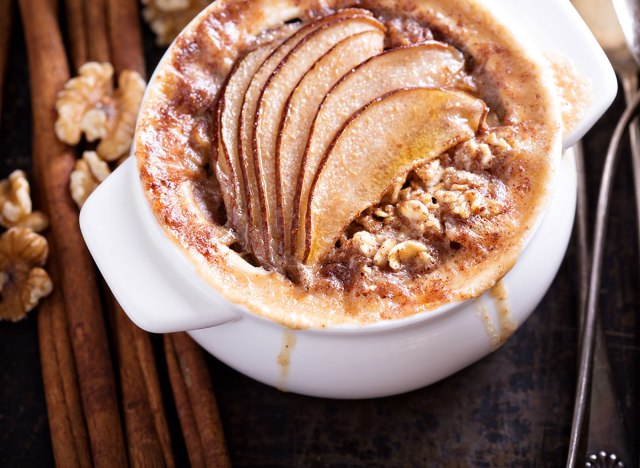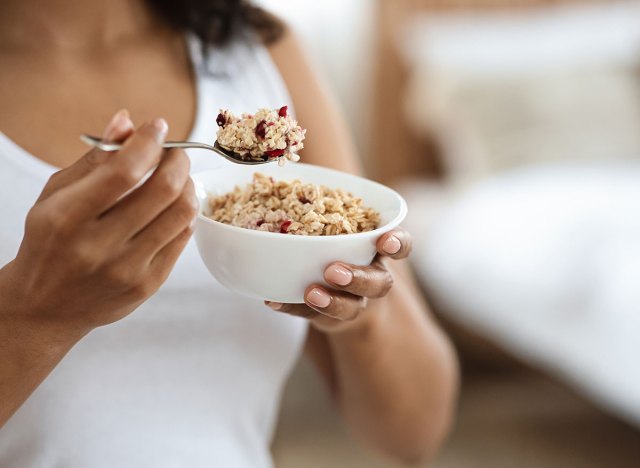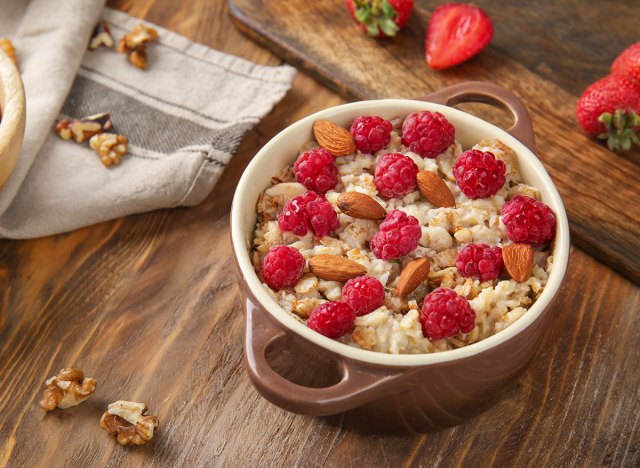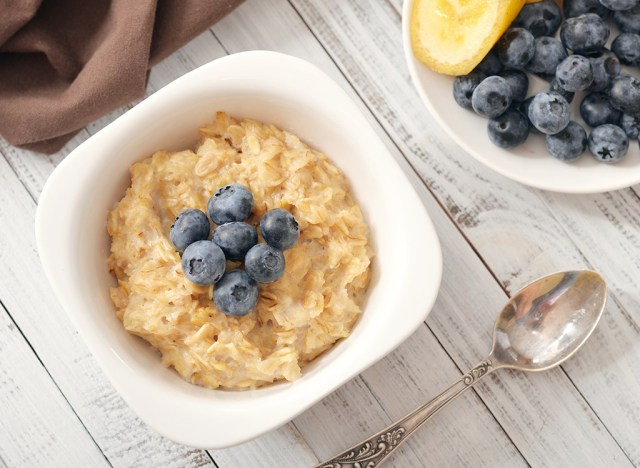Unseen What Happens To Your Body When You Eat Baked Oats
Baked oats are having a moment. Maybe you’ve been making them for years, or maybe you’re a bandwagon fan in the wake of the viral TikTok rendition—aren’t we all? Either way, the breakfast-food-turned-so-much-more is taking over kitchens across America. Mashed, cooked, and often combined with creative toppings, the dish makes for a tasty and relatively healthy treat.
Whether you like to bake a huge tray of oats to enjoy throughout the week, or you’re making single-serving baked oats for your breakfast in the morning, we had to ask ourselves: what exactly happens to your body when you eat baked oats? And is it at all different compared to regular oatmeal?
Read on to see what nutritionists think of the increasingly popular breakfast food, and for even more healthy eating tips, be sure to check out our list of The 7 Healthiest Foods to Eat Right Now.
You’ll feel more full.
“Baked oats are similar to standard oats,” says Rachel Fine, RRD and owner of To The Pointe Nutrition.Fine points out that because oats are a naturally gluten-free whole grain, they have plenty of health benefits that won’t bake-off.
Oats are a “fabulous source of carbohydrates and soluble fiber,” says Fine. Fine also explains how the carbohydrates and the fiber combined in baked oats help to create that key sensation you want after eating a meal: fullness.
“Carbohydrates promote satiety by triggering the release of certain hormones like insulin and leptin, both of which act to bring the body to a natural fullness following a meal,” says Fine. “Soluble fiber helps to slow digestion, which not only promotes a steady release of both insulin and leptin, but also further promotes that ‘full feeling’ during a meal- helping you to naturally manage portions.”
Did you know oatmeal is considered The One Breakfast Food To Eat for a Longer Life?
Your fiber and good bacteria levels will get a boost.
In today’s world, a little extra fiber is a big deal. According to Julie Miller Jones, PhD, LN, and member of the Grain Foods Foundation’s Scientific Advisory Board, less than 4% of the US population meets the requirement for dietary fiber.
How much fiber should we be eating? According to The American Heart Association, a person is recommended to eat between 25 to 30 grams of fiber per day. That’s a pretty significant increase from the estimated 15 grams the average person consumes daily.
“Oatmeal is a great source of [fiber]—regardless of grain type,” says Jones.
Fine adds that the soluble fiber in oats is beneficial in ways beyond just reaching the recommendation. It “promotes production of short-chain fatty acids (SCFAs) in the gut, which helps fuel our good bacteria,” she says.
A 1/2 cup serving of oatmeal contains 4 grams of fiber. Plus, if you add in other fiber-rich foods, like raspberries (4 grams for 1/2 cup) or chia seeds (2 grams per 1 teaspoon) your breakfast will give you 10 grams of fiber first thing in the morning!
Here are 9 Warning Signs You’re Not Eating Enough Fiber.
You could be a little gassy.
With all the great digestion and fiber side-effects of oats, maybe this is to be expected. Oats in general are known to occasionally cause intestinal gas and bloating, explains Amber O’Brien, a medical doctor working at Mango Clinic. And with the variety of ways baked oats can be incorporated into a diet, there is more potential for over-consumption, which in turn will worsen this side-effect.
The best way to minimize gas and bloating, according to O’Brien, is “by taking oats in low quantities and then increasing the amount gradually. It will make your body get used to the oatmeal hence no bloating.”
Properly portioning out your oats and following a recipe (similar to this one) is an easy way to ensure you won’t feel gassy or bloated after you eat baked oats. Or keep it simple with one of these 51 Healthy Overnight Oats Recipes!
Your energy will go up.
Forget that second cup of coffee—your baked oats have the power to wake you up, too.
“The carbohydrates in oats and fruit in a serving of baked oats are the main way our bodies utilize energy. This makes them a good choice for breakfast or even before a workout,” says Laura Zea, MS.
Definitely a different idea for a pre-workout, but Sarah Schlichter, MPH, RDN, of Bucket List Tummy backs Zea up. She recommends topping the baked oats with nut butter or yogurt for an added protein kick. Or even eggs!
“If you use eggs in your baked oatmeal, it will also provide small amounts of the branched-chain amino acid, leucine, which can help with muscle recovery and decreasing inflammation after exercise,” says Schlichter.
Your skin could improve.
Wait till the TikTok fandom hears this: not only are baked oats healthy and fun to make, they also might help keep your skin smooth and beautiful.
“Chances are, you’ve seen oatmeal in tons of skincare products. Eating the superfood can offer just as many benefits to your skin, if not more,” says John Fawkes, a nutritional counselor. Fawkes points out one study which shows how oats contain anti-inflammatory compounds which help fight the impacts of aging, including wrinkles.
Baked oats could be the key—but can you really eat your way to better skin? Fawkes says yes, “as long as you don’t include heaps of collagen-damaging sugar.”
Get even more healthy tips straight to your inbox by signing up for our newsletter!
The post What Happens To Your Body When You Eat Baked Oats appeared first on .




